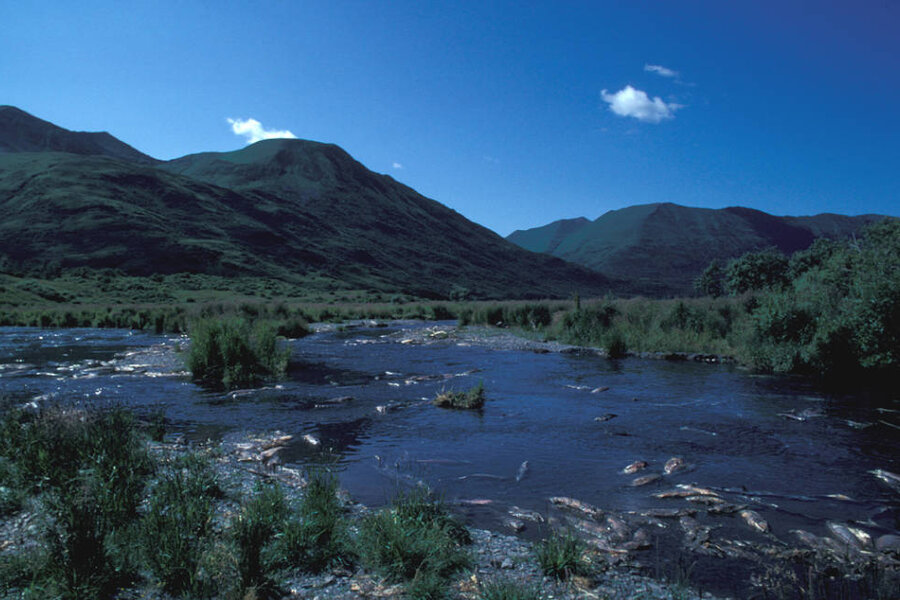Why the EPA wants to amend the Clean Water Act
Loading...
The Obama administration is looking to clarify the "water" in the Clean Water Act.
The Environmental Protection Agency released the finalized version of a new rule designed to address confusion over which streams and wetlands can be regulated under the landmark 1972 environmental legislation. At the heart of this confusion are so-called temporary waterways: small streams and tributaries that appear and disappear throughout the year due to rain, snowmelt, and other factors.
Taken individually, these seasonal streams are relatively small. Together, however, they are the lifelines of the nation’s major waterways, says restoration ecologist Margaret Palmer.
“Temporary streams can make up a large fraction of river networks and contribute the majority of water to many rivers,” says Dr. Palmer, executive director of the National Socio-Environmental Synthesis Center, in an e-mail. “These small ‘headwaters’ are important habitats for many organisms and also transport nutrients to larger waters. Damage to or pollution of these waters directly affect larger, downstream waters.”
Roughly 60 percent of America's streams are seasonal or temporary, according to the EPA, and one in three Americans – about 117 million people – get their drinking water from public utilities accessing these waterways.
According to the Obama administration, when it came to protecting those waterways, the EPA’s hands were tied by two “confusing and complex” Supreme Court decisions in 2001 and 2006.
The 2006 decision, in particular, sided narrowly with a Michigan developer who paved over a wetland to build a strip mall without a permit from the US Army Corps of Engineers. The Clean Water Act says the government can regulate any discharge into “navigable waters” – a term the Army Corps had interpreted broadly since the Act was established. But an unusual 4 to 1 to 4 majority split from the court provided a number of new interpretations. At the time, four justices said the law called for a restrictive view of federal jurisdiction to reach remote wetlands. Four others said the statute permits the government to take upstream actions to prevent downstream degradation of federal water resources, with Justice Anthony Kennedy ultimately siding with the restrictive view of the court.
Justice Antonin Scalia and three of his colleagues wrote that the Clean Water Act only protects wetlands "with a continuous surface connection" to navigable water – effectively excluding seasonal waterways.
Justice Kennedy offered his own interpretation of where federal jurisdiction ends. He wrote that wetlands are not under government jurisdiction when the effect on water quality is "speculative or insubstantial," and that the wetland needs to "significantly affect the chemical, physical, and biological integrity of other covered waters."
The split majority led to years of confusion, as lower courts were unsure which interpretation – Scalia's or Kennedy's – they should apply. The EPA, after reviewing more than 1,000 peer-reviewed studies on the issue, hopes the Clean Water Rule will finally put those issues to bed by clearly defining the characteristics of waterways that fall under the EPA’s jurisdiction.
Under the new rule any tributary showing “physical features of flowing water” would be included under head water protections, regardless of whether the tributary has flowing water year-round.
The rule faces stiff opposition from congressional Republicans, however, who describe it as an overreach from the federal government that will cause "economic hell." However, for environmental scientists and advocates, the change is vital to protecting one of the nation’s most valuable resources.
“The administration’s decree to unilaterally expand federal authority is a raw and tyrannical power grab that will crush jobs," said House Speaker John Boehner. "[T]he rule is being shoved down the throats of hardworking people with no input, and places landowners, small businesses, farmers, and manufacturers on the road to a regulatory and economic hell.”
The need to protect these waterways is likely to become even more important as changing climate brings increased floods and drought, says John Rumpler, senior attorney for Environment America, an environmental advocacy group based in Washington, D.C., and Boston.
“When you have drought that means you have lower water levels in streams and rivers and lakes which means pollution gets concentrated, and it also means that some rivers that used to flow year-round might now only be flowing some of the time,” Mr. Rumpler says.
That is the case in California, where snowpack in the Sierra Mountains traditionally feeds rivers that flow into the state's reservoirs. That snowpack has been declining dramatically in recent years, according to the Wall Street Journal. Snowpack in the Sierras dropped from 171 percent of normal in 2011 to 52 percent of normal in 2012, and this year sits at 5 percent.
Wetlands are also a crucial means of flood control, Rumpler says. A recent report from Environment America found that they also have been declining dramatically. Prior to the enactment of the Clean Water Act in 1972, wetlands were decreasing at an average rate of 458,000 acres per year, according to the US Fish and Wildlife Service. The rate of wetlands loss slowed throughout the following decades – even increasing by an average of 32,000 acres a year from 1998 to 2004 – until the 2006 Supreme Court decision. From 2004 to 2009, wetlands acreage decreased by 14,000 acres a year, according to the Environment America report.
An acre of wetland one foot deep can hold approximately 330,000 gallons of water, the report found, soaking up heavy precipitation like a sponge, slowing the velocity of runoff and retaining excess water, mitigating much of the damage a flood can cause. Overall, the nation's wetlands provide more than $237 billion worth of water flow regulation every year, the report says.
"Wetlands are a vital defense for our communities against flooding," Rumpler adds. "We want to make sure all of those waterways" – temporary streams and wetlands – "are protected by the Clean Water Act."








